|
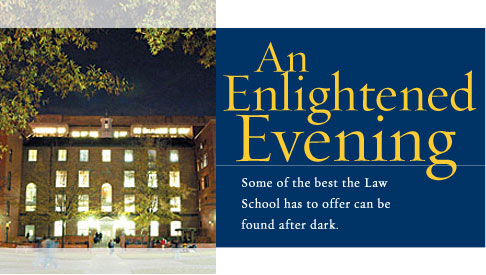
By Laura Ewald
When new evening law students and their families first meet Associate Dean for Student Affairs Renee DeVigne, she both welcomes them to and warns them about the road ahead. It will be worth it, she says. The demands placed on an evening law student—balancing a full-time job, family, and coursework—are considerable. But the rewards, often reaped because of the journey itself, are many.
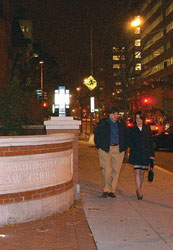
Students on 20th Street, along the Law School's new illuminated, etched concrete and brick walkway.
Photo by Claire Duggan
|
“I tell them to think of Fred Astaire, a legendary dancer admired for his grace and skill,” DeVigne says. “Then I tell them to think about Ginger Rogers, his dance partner. Even though she is not as famous, she danced every intricate step that Astaire did…and she did it backwards.”
Grace and skill are also required of and exemplified by today’s evening law students. Much like Rogers, they are not always the first to be recognized, but they are widely admired by those in the know. This is the story of evening students past and present—the steps they learn, the obstacles they overcome, and the corps of GW Law insiders who work to make the dance as smooth as possible.
The Law School of today is hardly recognizable to some alumni. Of course, this is because of the extensive physical changes the school has undergone in the past several years, with the expansion and renovation of Stuart and Lisner Halls.
For former evening student and Judge of the U.S. District Court for the Eastern District of Michigan Gerald Rosen, JD ’79—a member of the Law School's advisory board who recently visited campus for Colonials Weekend—the Law School has changed inside as well as out.
“Before I came to GW Law in the ’70s, I had been in East Germany and Russia. The physical amenities here at the time were not much better,” Rosen jokes. “The buildings were cold in the winter, hot in the summer, sparse, and there was nowhere for students to gather—instead of a lounge, my friends and I met at a hamburger joint on Pennsylvania Avenue. Now I come back to visit and I see how the students are enjoying the beautiful buildings and study spaces. It’s unbelievable, and the evening program itself has changed dramatically, too.”
The ability to connect with classmates was crucial to success and sanity during Rosen’s time as an evening student. While the Law School hasn’t always been able to provide the technology of today or ample space to do so, Rosen says the faculty encouraged students to rely on one another.
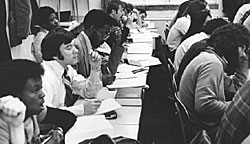
In the 1970s, evening students and day students alike learned in close quarters. While classes then were certainly mentally stimulating, students today enjoy a bit more breathing room.
|
“What saved me during my student days was my study group. On the first night of torts, Professor John Banzhaf said that this process would be terribly difficult, and that we would need to rely on one another. So he divided up the class by where we worked and where we lived and put us in different areas of the room. I ended up with a good group,” Rosen says. “Without them, I don’t know how I would have done it. We studied together, ate meals together, took notes for each other, and kept each other sane.”
These study group members—who have remained close friends—have come a long way from the hamburger joint. Don Bandler, JD ’79, previously was ambassador to Cyprus and now is senior director for Kissinger McLarty in Washington. Kay Casstevens, JD ’79, who formerly served as Vice President Gore’s legislative director and now is chief of staff to Rep. Chris Van Hollen (D.-Md.). Bob Van Heuvelan, JD ’79, is chief of staff to Sen. Kent Conrad (D-N.D.). Dayton Lehman, JD ’79, is deputy assistant general counsel to the Department of Transportation. And Laurie Michel, JD ’79, previously with Hogan & Hartson as well as Ballard, Spahr, now is senior director and counsel for Merck & Co.
Rosen says he is proud of the accomplishments of his friends and enjoys having the opportunity to witness such tangible change in the institution where they met.
“I’ve always been proud to be a part of the evening program. And now there is even more cause to be. It has continued to grow stronger over the years. When I was in the program, there were limited course offerings and not many adjuncts from the working world willing to teach,” says Rosen, who also teaches evidence as an adjunct professor at Wayne State University Law School. “But now the course selection is outstanding and the instructors teaching those classes are well-respected and experienced in their fields.”
Rosen’s comments echo those of fellow alumni and current students: tales of the hardships of the undertaking mixed with praise for the Law School’s faculty and resources as well as the steady evolution of the program. They tell of 40-hour work weeks, demanding classes and coursework and family and friends who do their best to understand why they don’t have time for social lives.
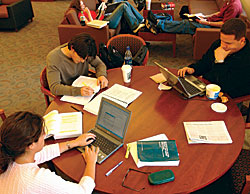
Recent renovations allow students more space to gather and study.
|
Emile Monette, president of the Evening Law Student Association, works during the day at a government contracts office, reporting at 6:30 a.m. so he can leave at 4 p.m. to squeeze in dinner with his wife and his young son before coming to campus for class at 6 p.m. He usually arrives home at 9 p.m., and his evenings and weekends are devoted to his studies.
“I’d like to have more time to get into the material, but there aren’t enough hours in the day or days in the week,” Monette says. “It’s hard not being able to give one hundred percent to any aspect of my life, be it my job, my family, or law school.”
But Monette, who also tries to find time to “go surfing and be a human,” says that while at times exhausting, the demands of the evening program are already paying off.
“I got the job I have, which is not an entry-level position, due to the experience I’ve had in the real world and the fact that I’m going to law school,” Monette says. “I think being an evening student is a big part of that package. The people in my classes are staffers on the Hill, engineers, patent workers…we’re already investments in our fields and to each other and our professors. The range of experience and the diversity of the students are what make the evening program so valuable and worthwhile.”
The evening programalso has unique rewards for evening instructors, adjunct professors and faculty members. Professor Robert Tuttle says he enjoys teaching evening students because of their strong work ethics and fresh outlooks.
“I rely on their experience and their dedication. They bring practical, fresh perspectives to the discussions,” Tuttle says. “I appreciate them for their preparedness and professionalism. These are often traits they’ve developed in an office environment, and these ethics and standards transition well into the classroom.”
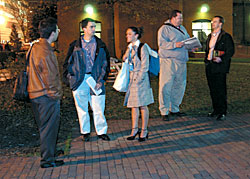
Evening students chat before class.
Photo by Claire Duggan
|
Professor Jeffrey Rosen says the perspective the evening students bring in from their jobs helps to keep the material interesting.
“They teach me about the practical effects of their careers and lives,” Rosen says. “That is exciting and unexpected for me; it keeps me on my toes. That helps me in my efforts to keep them engaged. It can be quite a task to keep them awake on a Friday evening after a long week. It’s a challenge for me as well as for them.”
Tuttle says having professional work experience translates well into the coursework—and beyond.
“Sometimes it’s hard for folks who don’t see the practice of law as a set of job skills to catch on to what works and what doesn’t work inside the classroom and, later, inside the courtroom,” Tuttle says. “Learning the law and practicing the law are active enterprises that require more than going to class and cracking open the textbooks. You have to not only gain the knowledge to succeed after law school, you have to gain the tools—work ethic, professionalism, personal presentation—and learn how to show that you can use them.”
To gain these skills, Tuttle says he sets the bar high for his evening students.
“I try to be understanding and accommodating to them, because I know what it’s like,” Tuttle says. “But the work itself demands a strict attendance policy and intellectual commitment. With all the priorities and pressures they have, I’m competing for their time and attention. It takes a lot, but it’s a privilege to see them rise to the challenge.”
As a result of teaching and watching evening students, Tuttle says he sometimes cuts his day students a little less slack.
“I’m less lenient to my day students. I tell them about the evening students, and as a result, they know there are no excuses,” he says. “It sometimes comes as a shock for the day students when they’re in their first year as an actual lawyer. That’s one advantage the evening students have: they’re ready to take on the pressure.”
Cindy Owens, JD ’03, says that her transition into the workforce was easier as a result of surviving the evening program.
“It really built up my stamina and taught me how to manage my time,” Owens says. “And it also gave me a chance to explore through my courses and internships. I got to work 30 hours a week in different places—a law firm, the Department of Justice, for example—so I really got to see, hands-on, what different jobs were like. The process helped me find out what I wanted to do as a lawyer.”
When painting an accurate picture of today’s evening law student, some Law School insiders says its imperative to not only discuss what a “typical” evening student is, but also what a typical evening student is not. Like the Law School itself, evening students are constantly evolving.
“These days evening students are not that different from day students in terms of age and overall career objective,” says Thomas Morgan, Oppenheim Professor of Antitrust and Trade Regulation Law. “There was a time when we had a caricature of an evening student as older, inevitably coming from another field. But today we have more and more students who, while they do have full-time jobs, have experiences and interests that help them transition into law coursework very smoothly. Today’s students don’t fit the romantic idea that they are in some way a foreign population—they are very much a vital part of the overall program.”
Morgan says this change in the evening student population has taken place during the last 10 years and is perhaps due in part to changes in the evening program itself.
“Our program attracts very accomplished, very unique people who are committed to practicing law,” Morgan says. “We attract these kinds of students because we have an increasingly selective evening program. This is not just a ‘convenient’ program. We use full-time, regular faculty to teach at night. We do not distinguish day from evening in this regard. That is not the case at all law schools. And because of these factors, our evening students have an experience that is different from the experience of the day students, but it is every bit as personal and high in quality.”
DeVigne, who works closely with Emile Monette and the rest of the student body by voicing their needs and concerns to the Law School, says she, too, has noticed change during the past few years.
“When I came here in 1999, I noticed there was not enough emphasis on the evening program. Many faculty members felt the same way. We started listening to the students, walking in their shoes. That’s not always easy, because these students are so independent and self-sufficient in their jobs and their personal lives that they don’t always reach out for help.”
Through trial and effort, DeVigne and her colleagues began, one step at a time, to shape a new evening program—one that would live up to the quality of its students.
Rosanne O’Hara, aids in that effort. O’Hara has two titles at GW Law: director of student administrative services and “heroine of the Law School.” The latter was given to her by Jeffrey Rosen. One of her many jobs is to make information and assistance readily available to the evening students. The school has given her many tools to meet this charge, some created at the students’ suggestion.
“We make every effort to accommodate the evening students, to help them feel at home,” O’Hara says. “At the students’ request, we offer Saturday classes in negotiations and trial advocacy, keep the records office open until 8 p.m., and have a Web portal that has updated information on their classes and other pertinent information.”
The Web portal, which O’Hara describes as “the biggest thing that makes students happy,” is constantly evolving to meet the needs of the school. Using the portal, students, faculty, and staff have access to up-to-the-minute Law School news. This includes class cancellations, course materials, descriptions, announcements, and syllabi. Students can also better connect thanks to the contact information, room reservation postings, even streaming video of classes if they are unable to attend. The Web portal also offers course and instructor evaluations from past semesters to help students make better choices about their schedule for the coming semesters.
“Technology has made it possible for us to serve the students better and better,” O’Hara says.
DeVigne says one way she and her colleagues try to help students is by encouraging them to ask for help—and take time off.
“Because these students are such hard workers and so dedicated to their lives and their studies, it’s important to encourage them to take a break,” DeVigne says. “These are super-organized, type-A personalities who are always on the go. I have to remind them to breathe.”
The Law School accommodates the students in this regard by helping students organize their schedules and showing them that they can take summers off.
“Sometimes, they are so eager to rush ahead and get everything done that they burn themselves out. I show them that they can take summers off to give them a few months to decompress,” DeVigne says. “And they can do that because we offer so many different classes at so many different times and days. We really work with each individual to make their lives as easy as possible.”
Before finally reaching graduation, the Law School takes one more step toward preparing evening students for the rest of their legal careers.
“While they do have professional experience in most cases, many students need help packaging themselves on paper for a legal career,” DeVigne says.
The Career Development Office helps evening students present their work and education experiences in a way that appeals to future employers, tailoring their resumes and cover letters to reflect the best of both worlds. Career counselor Ray Hazen helps students in this process by connecting them with the Law School’s internal and external career building resources.
“We introduce evening students to the legal resume format which is characterized by a generally conservative tone and the more neutral language favored by law firms. For students who want to practice law upon graduation, we help them devise a targeted search plan for contacting potential employers directly,” Hazen says. “This requires locating potential employers by practice and geographical area, reviewing and revising resumes and cover letters, setting a timetable for contacting employers that allows flexibility to control the process as much as possible, and debriefing employer responses and interviews.”
Hazen takes two different approaches to career counseling: assisting students who want to take direct advantage of his or her non-law career while searching for a legal position, or helping students who want to make a change from his or her pre-law career.
“If, for example, we are working with a stock broker wishing to practice securities law, we help students find the firms and lawyers practicing in that area and provide contact information of members of our Alumni Career Advisor Network who practice in that area,” he says. “As network members, these alumni have agreed to talk to students on an informational basis about their practice areas, how they came to them, what they do and do not like, and how to position themselves these areas.”
Hazen and the CDO staff also offer a range of career panels staffed by practicing lawyers and a mock interview program with alumni role playing as employers.
“It’s nice to be able to talk to alumni, people who have gone through the experience already,” Monette says. “That’s something we current students try to pass on to incoming students.
It’s nice to be able to say, ‘You can do this. As long as you really want to be here, there is a way.’ ”
DeVigne says she and her colleagues never tire of helping students navigate the program because the students give so much of themselves. This constant effort and interest on the part of the students inspires the faculty and staff to invest in each individual’s success.
“We are so proud of our students and so pleased that they have helped us establish this wonderful program,” DeVigne says. “Their enthusiasm and their feedback are what help the Law School get better and better.
“Once they are finished, I hear them say time and again, ‘How did I do that? How did I get through that?’ But they always—even years later—finish that thought by saying, ‘I’m so proud of myself and so glad that I did.’ ”
|
While enrollment in the day program is larger than enrollment in the evening program these days, that hasn’t always been the case. A look back in the books shows that the evening program has always been a significant part of the Law School.
• In the early 1890s, all law classes began after 6 p.m.
• In the spring of 1963, only 237 out of 774 students were enrolled in the day program.
• It wasn’t until October of 1963 that the IL day class size exceeded the number of students entering the evening program, 176 to 130.
• In March 1968, the Amicus Curiae—predecessor to the Nota Bene law student newspaper—noted that, “Certainly the removal of the deferred status from the part-time student, which an evening division law student is considered to be, placed a strong impetus on that student to become a full-time day student if at all possible.” The article proposed that this was one factor in the dramatic shift from evening to day enrollment during the 1960s.
• Since the 1960s, enrollment for the Law School’s day program has remained higher than enrollment for the evening program.
Special thanks to Associate Dean for Information Services and Law Library Director Scott Pagel.
|
Back to top | Fall 2004 Table of Contents
|